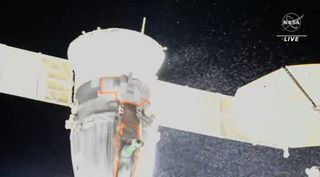Soyuz spacecraft suffers 'fairly substantial' leak at space station, cancels spacewalk by Russian cosmonauts
The "substantial" Soyuz coolant leak lasted more than 3 hours as Russian engineers investigate the problem.
A sizable coolant leak from one of Russia's Soyuz crew spacecraft docked to the International Space Station forced cosmonauts to cancel a spacewalk as flight controllers on the ground worked to troubleshoot the problem.
The leak, which a NASA spokes person described as 'fairly substantial,' was traced back to the coolant system of the Soyuz MS-22 spacecraft, was first detected on Wednesday (Dec. 14) at 7:45 p.m. EST (0045 GMT on Dec. 15), about an hour and 40 minutes before Expedition 68 crewmates Sergey Prokopyev and Dmitry Petelin of the Russian federal space corporation Roscosmos were scheduled to begin a 6-hour, 40-minute spacewalk. The extravehicular activity (EVA) was called off after the two cosmonauts had already donned their spacesuits and were in the process of depressurizing the airlock to begin the outing.
Instead, Prokopyev and Petelin, who were never in any danger, repressurized the airlock and reentered the space station.
Related: The most memorable spacewalks of all time in pictures

Cameras on the exterior of the space station showed a steady stream of frozen flakes being ejected from the Soyuz spacecraft into space. Although not yet confirmed, it was believed the source of the leak was an exterior coolant system located near the aft section of the vehicle.
"The cause of this leak [is] not known at this time," NASA spokesperson Rob Navias said during live commentary. "Russian specialists are continuing to look at the data and discussing what may have triggered the leak."
Flight controllers assured the cosmonauts that the space station, itself, was safe. The leak, however, did continue for at least three hours. NASA ended its live TV coverage of the incident at about 12:15 am EST on Thursday, promising updates vie the agency's online blog and social media channels.
"Experts in Moscow are going to be taking a look at their systems and responding to the leak according to their procedures and polices," NASA space station flight director Emily Nelson said during live NASA TV commentary. "Once they have a good understanding of the final status of the Soyuz tonight, we will then jointly make a decision about where to go forward from here."
Get the Space.com Newsletter
Breaking space news, the latest updates on rocket launches, skywatching events and more!
Russian cosmonaut Anna Kikina aboard the space station used the outpost's European Robotic Arm on its Russian segment to inspet the Soyuz MS-22 spacecraft as engineers at Russia's Mission Control Center in Moscow reviewed its telemetry and data.

The Soyuz MS-22 spacecraft launched in September with Prokopyev, Petelin and NASA astronaut Frank Rubio. In addition to being the three crewmates planned ride home in March, the vehicle also serves as a "lifeboat" should an emergency aboard the space station require an evacuation of the crew.
The status of the Soyuz to safely carry astronauts back to Earth is unknown. Roscosmos could launch an uncrewed Soyuz and autonomously dock it with the space station if needed.

This was the the second time that Prokopyev and Petelin had to cancel their EVA, which was planned to relocate a radiator from one Russian module to another. On Nov. 24, the two were getting ready to exit the space station when an issue was detected with a water coolant pump on Prokopyev's Orlan spacesuit.
The International Space Station is currently home to seven crewmembers. The crew includes three Russian cosmonauts, three U.S. astronauts with NASA and one Japanese astronaut. In addition to the Soyuz MS-22 spacecraft, there is a docked SpaceX Crew Dragon spacecraft that flew the other four crewmembers — NASA astronauts Nicole Mann and Josh Cassada, Japanese astronaut Koichi Wakata and Russian cosmonaut Anna Kikuna — to the space station in October.
Editor's note: This story was updated at 12:30 am ET on Dec. 14 to include new comments from NASA flight director Emily Nelson and the inspection of the Soyuz spacecraft by robotic arm.
Follow us on Twitter @Spacedotcom or on Facebook.
Join our Space Forums to keep talking space on the latest missions, night sky and more! And if you have a news tip, correction or comment, let us know at: community@space.com.

Robert Pearlman is a space historian, journalist and the founder and editor of collectSPACE.com, an online publication and community devoted to space history with a particular focus on how and where space exploration intersects with pop culture. Pearlman is also a contributing writer for Space.com and co-author of "Space Stations: The Art, Science, and Reality of Working in Space” published by Smithsonian Books in 2018. He previously developed online content for the National Space Society and Apollo 11 moonwalker Buzz Aldrin, helped establish the space tourism company Space Adventures and currently serves on the History Committee of the American Astronautical Society, the advisory committee for The Mars Generation and leadership board of For All Moonkind. In 2009, he was inducted into the U.S. Space Camp Hall of Fame in Huntsville, Alabama. In 2021, he was honored by the American Astronautical Society with the Ordway Award for Sustained Excellence in Spaceflight History.
